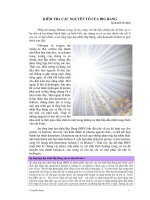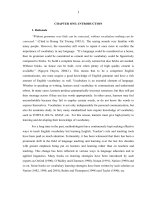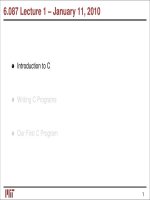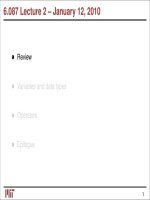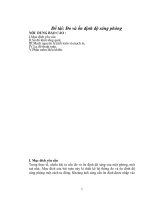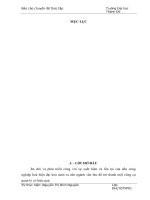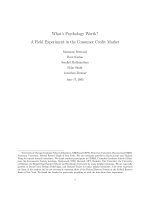Big endian vs. little endian (cont.)
Bạn đang xem bản rút gọn của tài liệu. Xem và tải ngay bản đầy đủ của tài liệu tại đây (213.25 KB, 30 trang )
6.087 Lecture 2 – January 12, 2010
Review
Variables and data types
Operators
Epilogue
1
Review: C Programming language
•
C is a fast, small,general-purpose,platform independent
programming language.
•
C is used for systems programming (e.g., compilers and
interpreters, operating systems, database systems,
microcontrollers etc.)
•
C is static (compiled), typed, structured and imperative.
•
"C is quirky, flawed, and an enormous success."–Ritchie
1
Review: Basics
•
Variable declarations:
int i ; float f ;
•
Intialization:
char c=’A’; int x=y=10;
•
Operators:
+,−,∗,/,%
•
Expressions:
int x,y,z; x=y∗2+z∗3;
•
Function:
int factorial (int n); /∗function takes int , returns int ∗/
2
6.087 Lecture 2 – January 12, 2010
Review
Variables and data types
Operators
Epilogue
3
Definitions
Datatypes:
•
The datatype of an object in memory determines the set
of values it can have and what operations that can be
performed on it.
•
C is a weakly typed language. It allows implicit conversions
as well as forced (potentially dangerous) casting.
Operators:
•
Operators specify how an object can be manipulated
(e.g.,, numeric vs. string operations).
•
operators can be unary(e.g., -,++),binary (e.g.,
+,-,*,/),ternary (?:)
3
Definitions (contd.)
Expressions:
•
An expression in a programming language is a
combination of values, variables, operators, and functions
Variables:
•
A variable is as named link/reference to a value stored in
the system’s memory or an expression that can be
evaluated.
Consider:
int x=0,y=0; y=x+2;
.
•
x, y are variables
•
y = x + 2 is an expression
•
+ is an operator.
4
Variable names
Naming rules:
•
Variable names can contain letters,digits and _
Variable names should start with letters.
•
•
Keywords (e.g., for,while etc.) cannot be used as variable
names
•
Variable names are case sensitive.
int x; int X
declares
two different variables.
Pop quiz (correct/incorrect):
•
int money$owed;
(incorrect: cannot contain $)
•
int total_count
(correct)
•
int score2
(correct)
•
int 2ndscore
(incorrect: must start with a letter)
•
int long
(incorrect: cannot use keyword)
5
Data types and sizes
C has a small family of datatypes.
•
Numeric (int,float,double)
•
Character (char)
•
User defined (struct,union)
6
Numeric data types
Depending on the precision and range required, you can use
one of the following datatypes.
signed unsigned
short
short int x;short y; unsigned short x;unsigned short int y;
default
int x; unsigned int x;
long
long x; unsigned long x;
float
float x;
N/A
double
double x;
N/A
char
char x; signed char x; unsigned char x;
•
The unsigned version has roughly double the range of its
signed counterparts.
•
Signed and unsigned characters differ only when used in
arithmetic expressions.
•
Titbit: Flickr changed from unsigned long (2
32
− 1) to string
two years ago.
7
Big endian vs. little endian
The individual sizes are machine/compiler dependent.
However, the following is guaranteed:
sizeof(char)<sizeof(short)<=sizeof(int)<=sizeof(long)
and
sizeof(char)<sizeof(short)<=sizeof(float)<=sizeof(double)
"NUXI" problem: For numeric data types that span multiple
bytes, the order of arrangement of the individual bytes is
important. Depending on the device architecture, we have "big
endian" and "little endian" formats.
8
Big endian vs. little endian (cont.)
•
Big endian: the most significant bits (MSBs) occupy the
lower address. This representation is used in the powerpc
processor. Networks generally use big-endian order, and
thus it is called network order.
•
Little endian : the least signficant bits (LSBs) occupy the
lower address. This representation is used on all x86
compatible processors.
Figure:
(from
9
Constants
Constants are literal/fixed values assigned to variables or used
directly in expressions.
Datatype example meaning
int i=3;
integer
long l=3;
long integer
integer
unsigned long ul= 3UL;
unsigned long
int i=0xA;
hexadecimal
int i=012;
octal number
float pi=3.14159
float
floating point
float pi=3.141F
float
double pi=3.1415926535897932384L
double
10

